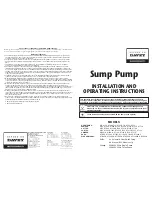
5
Line Voltage
• A wiring diagram is located on the inside cover of the
electrical box of the outdoor unit. The installer should
become familiar with the wiring diagram before making
any electrical connections to the outdoor unit.
•
An electrical disconnect must be located within
sight of and readily accessible to the unit.
This
switch shall be capable of electrically de-energizing
the outdoor unit.
• Line voltage to the unit should be supplied from a
dedicated branch circuit containing the correct fuse
or circuit breaker for the unit. Incoming field wiring
and minimum size of electrical conductors and circuit
protection must be in compliance with information listed
on the outdoor unit data label. Any other wiring methods
must be acceptable to authority having jurisdiction.
• The outdoor unit requires both power and control circuit
electrical connections. Refer to the wiring diagrams
(
Figure 13
,
Figure 14
, &
Figure 15
) for identification and
location of outdoor unit field wiring interfaces. Make all
electrical connections in accordance with all applicable
codes and ordinances.
• Overcurrent protection must be provided at the branch
circuit distribution panel and sized as shown on the unit
rating label and according to applicable local codes.
See the unit rating plate for minimum circuit ampacity
and maximum overcurrent protection limits.
• Provide power supply for the unit in accordance with the
unit wiring diagram, and the unit rating plate. Connect
the line-voltage leads to the terminals on the contactor
inside the control compartment.
• Use only copper wire for the line voltage power supply
to this unit as listed in
Table 1
. Use proper code agency
listed conduit and a conduit connector for connecting
the supply wires to the unit. Use of rain tight conduit is
recommended.
• 208/230 Volt units are shipped from the factory wired
for 230 volt operation. For 208V operation, remove the
lead from the transformer terminal marked 240V and
connect it to the terminal marked 208V.
2. Insert a light-gauge wire hook between the valve body
and the restrictor orifice while being careful not to scratch
either part. Carefully remove the restrictor orifice from
the valve body. See
Figure 3 (page 4).
3. Check the actual size of the new orifice.
NOTE:
The
size is stamped on its side. Do not use pin gauges to
measure the orifice diameter.
4. Insert the new orifice into the valve body, with the
rounded end facing into the valve. See
Figure 2 (page
4)
.
CAUTION:
To prevent damage to the unit or internal
components, it is recommended that two
wrenches be used when loosening or tightening
nuts. Do not over tighten!
5. Realign the assembly nut on the valve body and hand
tighten both components. Mark a line on both bodies and
then tighten an additional ¼ turn using two wrenches.
The movement of the two lines will show how much the
nut is tightened.
ELECTRICAL WIRING
WARNING:
To avoid risk of electrical shock, personal
injury, or death, disconnect all electrical power
to the unit before performing any maintenance
or service. The unit may have more than one
electrical supply.
Label all wires prior to disconnection when
servicing the unit. Wiring errors can cause
improper and dangerous operation.
• All electrical connections must be in compliance with
all applicable local codes and ordinances, and with the
current revision of the National Electric Code (ANSI/
NFPA 70).
• For Canadian installations the electrical connections
and grounding shall comply with the current Canadian
Electrical Code (CSA C22.1 and/or local codes).
Pre-Electrical Checklist
√
Verify that the voltage, frequency, and phase of the
supply source match the specifications on the unit
rating plate.
√
Verify that the service provided by the utility is sufficient
to handle the additional load imposed by this equipment.
Refer to the unit wiring label for proper high and low
voltage wiring.
√
Verify factory wiring is in accordance with the unit wiring
diagram. Inspect for loose connections. See
Figure 13
(page 21)
,
Figure 14 (page 22)
, &
Figure 15 (page
23)
.
COPPER WIRE SIZE — AWG
(1% VOLTAGE DROP)
SUPPLY WIRE LENGTH-FEET
SUPPLY
CIRCUIT
AMPACITY
200
150
100
50
6
8
10
14
15
4
6
8
12
20
4
6
8
10
25
4
4
6
10
30
3
4
6
8
35
3
4
6
8
40
2
3
4
6
45
2
3
4
6
50
2
3
4
6
55
1
2
3
4
60
Wire Size based on N.E.C. for 60° type copper conductors.
Table 1. Copper Wire Size






































